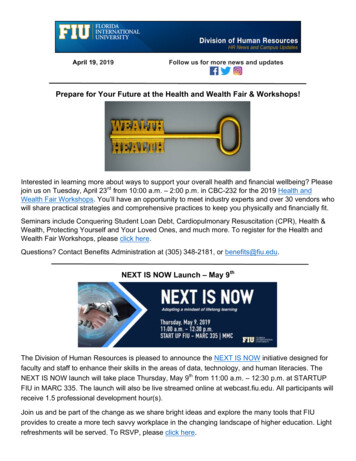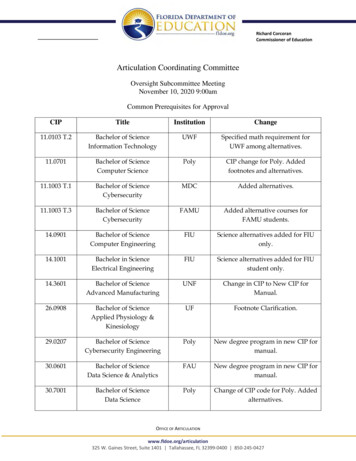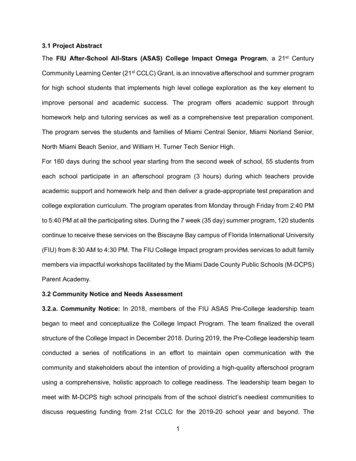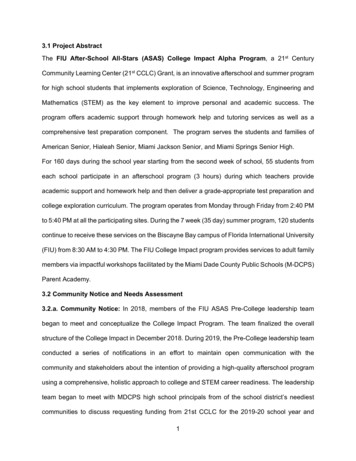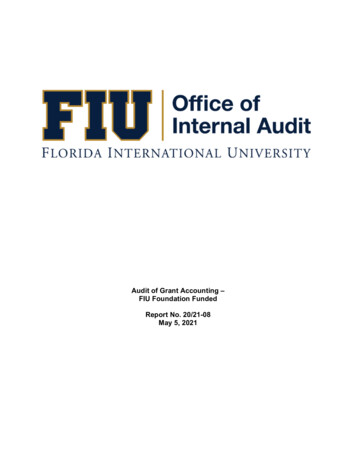
Transcription
Audit of Grant Accounting –FIU Foundation FundedReport No. 20/21-08May 5, 2021
Date:May 5, 2021To:Howard R. Lipman, Senior Vice President, University Advancement andCEO, FIU Foundation, Inc.From:Trevor L. Williams, Chief Audit ExecutiveSubject: Audit of Grant Accounting – FIU Foundation FundedReport No. 20/21-08We have completed an audit of Grant Accounting – FIU Foundation Funded for theperiod July 1, 2019, through June 30, 2020, and an assessment of the current practicesthrough March 1, 2021. The primary objectives of our audit were to determine whether:(a) there are adequate and effective controls in place for the proper administration ofFIU Foundation-funded research, (b) there are adequate controls in place to detect andprevent researchers from circumventing the Foundation and University grant approvalprocesses, and (c) Foundation-funded research funds are used properly in accordancewith gift requirements and University policies and procedures.During the audit period, there were 51 active Research Projects, which incurredexpenses totaling 1,730,463. For the same period, there were seven ResearchProjects that were opened with contributions totaling 745,712.Our audit found that apart from a specific instance related to the reimbursement ofexpenses connected to a donor’s quid pro quo contribution detailed in the report,Research Project funds were used consistent with the gift requirements and Universitypolicies and procedures. In addition, we found no instances of researcherscircumventing the University’s grant approval process through the Foundation orauxiliaries. Also, we noted that the Research Project administration training provided isrobust but lacks a monitoring component. The audit resulted in three recommendations,which management has either already addressed or agreed to implement.We want to take this opportunity to express our appreciation to you and your staff forthe cooperation and courtesies extended to us during the audit.AttachmentC: FIU Board of TrusteesFIU Foundation Board of DirectorsMark B. Rosenberg, University PresidentKenneth G. Furton, Provost, Executive Vice President, and Chief Operating OfficerKenneth A. Jessell, Senior Vice President and Chief Financial OfficerJavier I. Marques, Vice President and Chief of Staff, Office of the President
TABLE OF CONTENTSPageOBJECTIVES, SCOPE, AND METHODOLOGY .1BACKGROUND .2Project Funding: Approval and Setup .2Project Spending.4Project Closeout.4OBSERVATIONS AND RECOMMENDATIONS .5Areas within the Scope of the Audit Tested without Exception .6Policies and Procedures .6Detecting Circumvention of Grant Approval Process.6Project Approval and Setup .6Payroll Reimbursements for Research Projects .7Cost Transfers .7Reporting to Sponsors .7Unusual Project Expenses .7Project Closeout .8Areas within the Scope of the Audit Tested with Exception .91. Non-Payroll Expenditures for Research Projects .92. Monitoring of Training . 12APPENDIX I – COMPLEXITY RATINGS LEGEND . 13APPENDIX II – OIA CONTACT AND STAFF ACKNOWLEDGMENT . 14
OBJECTIVES, SCOPE, AND METHODOLOGYPursuant to the approved annual plan for the 2020-2021 fiscal year, we have completedan audit of Grant Accounting – FIU Foundation Funded for the period July 1, 2019,through June 30, 2020, and an assessment of current practices through March 1, 2021.The primary objective of our audit was to develop an understanding of the operatingenvironment and determine if: (a) existing controls are adequate and effective for theproper administration of FIU Foundation-funded research activities that are not routedthrough or managed by the Office of Research and Economic Development (ORED); (b)the funds related to said research activities are used properly, in accordance to the giftrequirements and University policies and procedures; and (c) existing controls preventand detect researchers from circumventing the Foundation and University grant approvalprocess.The audit was conducted in conformance with the International Standards for theProfessional Practice of Internal Auditing, promulgated by The Institute of InternalAuditors. The audit included tests of the supporting records and such other auditingprocedures, as we considered necessary under the circumstances. Audit fieldwork wasconducted from January 2021 through March 2021.During the audit, we: Reviewed University policies and procedures, and applicable statutes, rules, andregulations (federal and state, accordingly).Interviewed personnel and documented the various facets of Foundation-fundedresearch activities.Tested the adequacy of internal controls and processes (i.e., project opening,spending, closeout) via transactions testing for Foundation-funded researchactivities not managed by ORED.Evaluated the effectiveness of processes in place for preventing and detectingresearchers who may circumvent the Foundation’s/University’s grant approvalprocess.Applied data analysis techniques to flag potential anomalies related to Foundationfunded research activities (not managed by ORED).Sample sizes and transactions selected for testing were determined on a judgmental basisapplying a non-statistical sampling methodology.As part of the audit, we reviewed all internal and external audit reports that had beenissued during the last three years and found no reports with any applicablerecommendations related to the scope and objectives of this audit, which otherwise wouldhave required follow-up. An external audit of the Foundation’s financial statements for thefiscal year ended June 30, 2020, concluded that the financial statements were presentedfairly, in all material respects.Page 1 of 14
BACKGROUNDFlorida International University Foundation, Inc. (“FIU Foundation” or “Foundation”) wasestablished in 1969 to encourage, solicit, receive, and administer gifts for scientific,educational, and charitable purposes for the advancement of Florida InternationalUniversity and its objectives. It is registered by the State of Florida as a charitableorganization and is approved by the U.S. Internal Revenue Service as a tax exempt501(c)(3) organization. The Foundation has also been certified as a Direct SupportOrganization (DSO) of Florida International University as defined in Florida StatuteChapter 1004 Section 28.Project Funding: Approval and SetupAn FIU Foundation Project (7-digit number in PantherSoft) must be created to trackdonations received and related expenses, as allowed per the donor’s documentedintent. The respective departments request a new project to be created bysubmitting an electronic New Foundation Project Request Form along with anysupporting documents to the Foundation. The form must be electronicallyapproved by the department’s organizational approvers, followed by approval fromthe Foundation Business Office.Each project is assigned a type, based on the nature of the gift. The distinct projecttypes and their corresponding descriptions are noted below with those subject tothis audit in bold type.Table 1: Foundation Project TypeProject TypeDescriptionAdmin Oper Fund (ADMOP)Administrative operating fundAnnual Fund (ANNFD)Annual fund/capital campaignBuilding (BUILD)Building fundChairs (CHAIR)To fund a chairFaculty Development (DEVEL)To provide funds for faculty development,support, and recognitionDiscretionary (DISCR)Discretionary fundsFellowships (FELLO)To fund fellowshipsGeneral Reserve (GENRS)To fund general reserveInvestment (INVST)Foundation InvestmentsProfessorship Faculty (PROFS)Professorship fundsResearch (RESER)To fund Research ProjectsSponsored Research (SPRES)To be used solely for projects managed byOREDPrograms (PROGR)To provide funds for the benefit of programs in aschool or departmentScholarship (SCHOL)To fund scholarshipsStudent Support (STDNT)Student supportFirst Gen Scholarships (SCHFG)To fund First Generation Scholarship projectsSource: FIU Foundation’s Instructions for the Foundation Project Request e-FormPage 2 of 14
To test the objectives of our audit, we focused primarily on Research Projects, with alimited review of Sponsored Research Projects. A project should be managed byORED (Sponsored Research) if one or more of the following criteria are present: Research involves human subjects.Research involves animal subjects.Research involves controlled substances.1Sponsor requires detailed fiscal reportingor other limits.2There were 51 active3 Research Projects withdonations totaling 2,011,369 and expenditures totaling 1,730,463 during the fiscalyear ended June 30, 2020. For the same period, there were seven Research Projectsthat were opened, with donations totaling 745,712; four of which incurred expensesduring the period totaling 77,159.Total Active Projects (51) during Fiscal Year EndedJune 30, 2020, by Age2520Count1510500 - 3 Years4 - 7 Years18 - 11 Years20 - 21 YearsControlled substances are specific materials regulated by the United States Drug Enforcement Administration (DEA),and are used for research and instructional purposes at the University. These substances and their possession areregulated to ensure safety and prevent the potential for abuse.2 Includes intellectual property provisions, budget restrictions, audit provisions, publication restrictions, export controls,University personnel subject to institutional monitoring plans, or other items commonly regulated via the electronicproposal routing approval form (ePRAF).3 Defined as a project that either received funds or incurred expenses during the period July 1, 2019, to June 30, 2020.Page 3 of 14
Project SpendingProject expenditures may either be incurred by the University (identified asbusiness unit “FIU01” in PantherSoft) and later reimbursed by the Foundation(identified as business unit “FIU02”) or be paid directly to the supplier by theFoundation using an Electronic Invoice Form. For both instances, the followingquestions must be asked, prior to the expense being funded by the project:Source: Foundation Disbursement Policy & Procedure SummaryThe FIU Foundation, Inc. Disbursement Procedure describes the processregarding the reimbursement of expenses from Foundation funds related tobusiness meals, travel, gifts, events, honoraria, and athletic event tickets. No fundsare permitted to be advanced for any project, prior to the receipt of the donationintended to fund the expense. Moreover, if a project has insufficient funds, theexpense will not be paid from the Foundation funds and the respective departmentwill have to use a backup funding source. Electronic Invoice Forms are typicallysubmitted within 60 days of the goods being provided or the service beingrendered, unless there are extenuating circumstances which must be documented.Salaries for Research Projects are paid by the University and posted to fund 604(Transfer to Component Units) for reimbursement from the Foundation. Eachmonth, after the University has closed the accounting period, the Foundation runsa query of all payroll paid by fund 604. The Foundation then reaches out to thecorresponding departmental approvers to identify which project numbers shouldfund the reimbursement(s). Once received, the Foundation reviews, approves andthen transfers the funds to the University via wire transfer.Project CloseoutResearch Projects (not managed by ORED) are rarely closed out due to the ongoing fundraising and open-ended life of such research. These project types areclosed if the project was opened in error or if the department asks that the projectbe closed (e.g., an annual event, such as the Global Health Consortium that hasa new project opened each year). If projects are closed, the status withinPantherSoft is changed to “C” or closed. This new status (“C”) preventstransactions from being posted to the project. During the audit period (July 1, 2019,through June 30, 2020), there were two Research Projects that were closed.Page 4 of 14
OBSERVATIONS AND RECOMMENDATIONSIn summary, we noted that there are adequate and effective controls in place for theproper administration of FIU Foundation-funded research not managed by ORED. Apartfrom the specific instance related to the reimbursement of expenses connected to adonor’s quid pro quo contribution detailed later in this report, Research Project funds areused consistent with the gift requirements and University policies and procedures. Inaddition, we found no instances of researchers circumventing the University’s grantapproval process through the Foundation or auxiliaries. Also, we noted that the ResearchProject administration training provided is robust but lacks a monitoring component. Ourobservations and recommendations pertaining to reportable conditions found are detailedon the following pages of this report. We have also included management’s response toour observations and recommendations, along with their implementation dates. Ouroverall assessment of internal control is presented in the table below.CRITERIAOPPORTUNITIESTO IMPROVESATISFACTORYProcess ControlsXPolicy & Procedures ComplianceXEffectXInformation RiskXExternal RiskXINADEQUATEINTERNAL CONTROLS LEGENDCRITERIAProcess Controls(Activities established mainlythrough policies and procedures toensure that risks are mitigated, andobjectives are achieved.)Policy & Procedures Compliance(The degree of compliance withprocess controls – policies andprocedures.)Effect(The potential negative impact tothe operations- financial,reputational, social, etc.)SATISFACTORYOPPORTUNITIESTO IMPROVEINADEQUATEEffectiveOpportunities existto improveeffectivenessDo not exist or are notreliableNon-complianceissues are minorNon-complianceissues may besystematicNon-compliance issuesare pervasive,significant, or havesevere consequencesNot likely to impactoperations orprogram outcomesImpact on outcomescontainedNegative impact onoutcomesInformation Risk(The risk that information uponwhich a business decision is madeis inaccurate.)Information systemsare reliableData systems aremostly accurate butneed to be improvedSystems produceincomplete or inaccuratedata which may causeinappropriate financialand operationaldecisionsExternal Risk(Risks arising from events outsideof the organization’s control; e.g.,political, legal, social, cybersecurity,economic, environment, etc.)None or lowPotential for damageSevere risk of damagePage 5 of 14
Areas within the Scope of the Audit Tested without Exception:Policies and ProceduresWe conducted a walkthrough of key processes (i.e., project approval and setup,spending, and closeout) associated with Foundation-funded Research Projects.We then evaluated existing governing documents to determine if they adequatelyencompassed guidance for such processes. We concluded that the Foundationhas established a robust set of policies and procedures which address keyprocesses related to Research Projects.Detecting Circumvention of Grant Approval ProcessORED has developed a roadmap, as depicted in their Gifts, Grants, & OtherExternally Sponsored Activities Decision Tree, which sets controls in place tomitigate the risk of researchers circumventing the University’s grant approvalprocess, and improperly receiving funds via an auxiliary fund.We reviewed auxiliary revenue activity using distinct factors (i.e., general ledgeraccount, amount, supplier) to identify potential grant/research funds that may havecircumvented the Foundation or ORED and reviewed those flagged to determinewhere funds originated. We did not identify any funds which were wrongfully routedthrough an auxiliary.Additionally, we judgmentally selected a sample of five research publications (of2,235 such publications) from WebofKnowledge.com, which identify projectsinvolving the University. We limited our review to five publications, due to thenature of these publications and the complexity involved with correlating a projectto the related publication. We concluded that none of the five projectscircumvented the University’s grant approval process.Project Approval and SetupWe reviewed four of the seven Research Projects that were opened during theaudit period to determine if such projects were properly approved and setup. Wedetermined that for all projects sampled, an FIU Foundation Project DescriptionForm was completed, approvals were obtained from the respective deans, and thecontributed funds were allocated to the correct project number.Additionally, we reviewed all seven Research Projects opened during the periodto determine if ORED, rather than the Foundation, should have managed theproject. We noted that none of the projects tested involved human subjects, animalsubjects, or controlled substances. Moreover, projects did not require detailedfiscal reporting. Therefore, we concluded that Research Projects were properlyapproved and setup by the Foundation.Page 6 of 14
Payroll Reimbursements for Research ProjectsFor the period audited, there were 20 Research Projects that had payrollreimbursements totaling 448,859. We judgmentally selected a sample of 10projects, with payroll-related expenditures totaling 366,108 (444 transactions)and tested 25 transactions, totaling 73,614.We validated that the payroll reimbursements tested were properly supported andthat wages paid adhered to the corresponding project budgets. Lastly, we verifiedthat personnel paid was allowed, and in instances when there were personnelchanges, prior approval was obtained. As a result, we concluded that payrollexpenditures for the Research Projects tested were used in accordance with giftrequirements, as well as University policies and procedures.Cost TransfersA cost transfer is an after-the-fact allocation of costs associated with a transactionfrom one project to another. Cost transfers are identified by the terms, “reclass”,“transfer”, and/or “adjust” within the journal header description by the Foundation.We identified three cost transfers, totaling 181,162, which were processed duringthe audit period. We sampled two of the cost transfers, which totaled 100,295and noted that the transactions were allowable, reasonable, adequately supported,and properly approved.Reporting to SponsorsGift agreements may require periodic reporting to Sponsors. To ensure that suchterms are being met, we identified all Research Projects that incurred expenses(payroll and non-payroll) during the period. Of the 51 active projects, wejudgmentally selected a sample of 20 projects, with expenditures totaling 1,311,859 and reviewed the corresponding New Project Forms and giftagreements, to determine if the projects required reporting to the Sponsor. Wenoted that 10 of the 20 projects reviewed, required additional reporting. Wesubsequently tested five of the 10 projects and noted that reporting was preparedin accordance with the Sponsors’ requirements or extensions for reporting andwere timely requested and approved.Unusual Project ExpensesWe applied data analytics to identify anomalies in Research Project expenses. Aspart of our analyses, we were seeking to identify: project expenses that occurred before the project start date,project expenses that occurred after the project close date,individuals who were paid more by Research Projects than their University(FIU01) salaries,Page 7 of 14
individuals who were paid twice within the same paycheck and for the sameproject,individuals who received salary reimbursements near the project close date,unusual cost transfers, andunusual burn rates4 in the last four to six weeks before the project closedate.We noted that expenses flagged from the above analyses were proper andallowable, based upon our detailed auditing procedures applied.Project CloseoutThere were two Research Projects that were closed during the audit period. Uponfurther review of these instances, we noted that neither project exceeded itsbudget. Instead, both projects had unused funds, totaling 176,912, and wevalidated that approval to reallocate the funds to another project was obtained fromthe respective sponsors.4The rate at which funding is being spent.Page 8 of 14
Areas within the Scope of the Audit Tested with Exception:1. Non-Payroll Expenditures for Research ProjectsFor the period audited, there were 38 Research Projects that had non-payrollexpenses, totaling 1,281,603. We judgmentally selected a sample of 14 projects,with non-payroll related expenditures totaling 1,034,216 (117 transactions) andtested 25 transactions, totaling 771,605.We reviewed the sampled items to determine if expenses were allowable, allocable,reasonable, and consistent. We noted one instance (of 25), in which an expense inthe amount of 43,614 did not appear to be allowable or reasonable. This expensewas for a travel reimbursement for a research trip to the Bahamas related to sharkconservation. The reimbursement was for lodging and fuel for the period of March 1,2019, through March 7, 2019. Furthermore, we found that a Travel Authorization wasnot approved by the University until October 10, 2019. The FIU Foundation, Inc.Disbursement Procedure states:“All travel must have a valid Travel Authorization (TA) per Universitypolicies. Travel Authorizations are only valid if they are approvedprior to the travel occurring.”As a result, a Non-Conforming Purchase form was completed and signed by theExpense Manager, the Business Unit Head, the Director of Purchasing, and theProvost, subsequent to the trip having occurred.The travel reimbursement was based on lodging for eight travelers. However, upon adetailed review, we noted that four of the eight travelers were members of the donor’sfamily. This donor had gifted the Foundation 45,000 in February 2019 for sharkconservation. The FIU Foundation, Inc. Disbursement Procedure states:“All guest/spouse travel reimbursed by the Foundation must includean approved Travel Authorization Request, original receipts, and aFoundation Unencumbered Payment Form. All guest/spouse travelmust be documented to the exact same standard as employee traveland will be reimbursed to the same amounts. Additionally, the formmust state the business purpose served by guest or spouse’s travel.If this business justification is excluded, no reimbursement will bepaid.”For the instance noted above, the business justification for the four guests was notdocumented and the expense was approved by the department’s budget approversand submitted to the Foundation for reimbursement, which was ultimately approvedand paid. Instead, the Department’s backup funding source should have been used.Page 9 of 14
Subsequent to our inquiry, the Biological Sciences Department conducted an analysisand noted that 28,718 should not have been deposited into the Foundation account.The IRS’ Publication 1771 (Rev. 3-2016), Charitable Contributions – Substantiationand Disclosure Requirements states:“Donors may only take a contribution deduction to the extent thattheir contributions exceed the fair market value of the goods orservices the donors receive in return for the contributions; therefore,donors need to know the value of the goods or services. Anorganization must provide a written disclosure statement to a donorwho makes a payment exceeding 75 partly as a contribution andpartly for goods and services provided by the organization. Acontribution made by a donor in exchange for goods or services isknown as a quid pro quo contribution.”The Publication goes on to state:“An organization must furnish a disclosure statement in connectionwith either the solicitation or the receipt of the quid pro quocontribution.”A written disclosure statement for the 45,000 was provided to the donor in February2019 when the gift was received. However, subsequent to the donor’s receipt of goodsor services, a revised written disclosure statement was not provided.The remaining 24 transactions tested appeared to be allowable, allocable,reasonable, and consistent.RecommendationsThe FIU Foundation should:1.1Expand the FIU Foundation, Inc. Disbursement Procedure to require disclosureof the affiliation of each traveler, prior to approving the reimbursement.1.2Provide the donor with a written disclosure statement in accordance with theIRS rule for charitable contributions to exempt organization and 26 U.S. CodeSection 6115 – Disclosure related to quid pro quo contributions, which notesthe value of the goods and services provided.Page 10 of 14
Management Response/Action Plan1.1 We concur with the Auditor's recommendation. Management is currently working onupdating the FIU Foundation, Inc. Disbursement Procedure to require affiliation ofany traveler.Implementation date: June 30, 2021Complexity rating: 2 – Moderate1.2 We concur with the Auditor's recommendation. On April 16, 2021, a revised writtendisclosure statement, which included the value of the goods and services received,was mailed to the donor.Implementation date: April 16, 2021Complexity rating: 1 – RoutinePage 11 of 14
2. Monitoring of TrainingTraining materials for Foundation-funded Research Projects are robust and providesufficient guidance related to the grant administration process. However, due to theway the Foundation makes training accessible to departments (e.g., via PDFs andvideos), we are unable to determine if key personnel completed relevant ResearchProject administration training. Thus, the existing training program does not have amonitoring component. Tracking employee performance provides detailed informationabout how well employees are engaging with the training content, determines theoverall effectiveness of the program, and documents compliance.Failing to monitor the training program may result in employees not adhering toUniversity policies and donor requirements.RecommendationThe FIU Foundation should:2.1Work with the Division of Information Technology to explore the feasibility ofincorporating the Research Project administration training programs within FIUDevelop to enable the Foundation to effectively monitor employeecomprehension of the project administration process and documentcompliance.Management Response/Action Plan2.1 We concur with the Auditor's recommendation. Management will work on exploringthe feasibility of incorporating a monitoring component to Foundation ResearchProject administration training.Implementation date: December 31, 2021Complexity rating: 3 – ComplexPage 12 of 14
APPENDIX I – COMPLEXITY RATINGS LEGENDLegend: Complexity of Corrective Action1Routine: Corrective action is believed to beuncomplicated, requiring modest adjustment to a processor practice.2Moderate: Corrective action is believed to be more thanroutine. Actions involved are more than normal and mightinvolve the development of policies and procedures.3Complex: Corrective action is believed to be intricate. Thesolution might require an involved, complicated, andinterconnected process stretching across multiple unitsand/or functions; may necessitate building newinfrastructures or materially modifying existing ones.4Exceptional: Corrective action is believed to be complex,as well as having extraordinary budgetary and operationalchallenges.Page 13 of 14
APPENDIX II – OIA CONTACT AND STAFF ACKNOWLEDGMENTOIA contact:Joan Lieuw 305-348-2107 or jlieuw@fiu.eduContributors to the report:In addition to the contact named above, the following staffcontributed to this audit in the designated roles:Natalie San Martin (auditor-in-charge)Manuel Sanchez (supervisor and reviewer)Vivian Gonzalez (independent reviewer)Page 14 of 14
Definition of Internal AuditingInternal auditing is an independent, objective assurance and consultingactivity designed to add value and improve an organization’s operations. Ithelps an organization accomplish its objectives by bringing a systematic,disciplined approach to evaluate and improve the effectiveness of riskmanagement, control, and governance processes.
CEO, FIU Foundation, Inc. From: Trevor L. Williams, Chief Audit Executive. Subject: Audit of Grant Accounting - FIU Foundation Funded . Report No. 20/21-08. We have completed an audit of Grant Accounting FIU Foundation Funded- for the period July 1 , 2019, through June 30, 2020, and an assessment of the current practices
